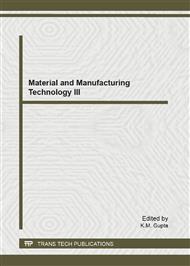p.138
p.143
p.147
p.153
p.160
p.165
p.169
p.174
p.181
Thermo-Mechanical Coupled and Fracture in Diamond Film under High Strain Rate
Abstract:
According to the special case of high strain rate for diamond film produced by DC plasma jet method, a transient thermo-mechanical coupled model for the cooling process of diamond film and Mo substrate was developed. The direct coupled finite element method was used to simulate the transient thermal stresses in diamond film during the cooling period after the film deposition. The residual thermal stresses of diamond film were calculated and compared respectively under two conditions of real uneven temperature fields and unreal even temperature fields. Based on the simulated results of stresses, the moment and cause of diamond film cracking were analyzed. The conclusions are as the follows: (1) the thermal stresses in diamond film increase with the increase of cooling time, but the maximum first principal tensile stress may reach the fracture strength of common diamond film before the film cools to room temperature; (2) the excessive tensile stress at the film edge causes the film cracking; (3) in order to reduce the thermal (residual ) stresses and increase the finished product ratio of diamond film, it is essential to further improve the temperature uniformity.
Info:
Periodical:
Pages:
160-164
Citation:
Online since:
July 2012
Authors:
Price:
Сopyright:
© 2012 Trans Tech Publications Ltd. All Rights Reserved
Share:
Citation:


